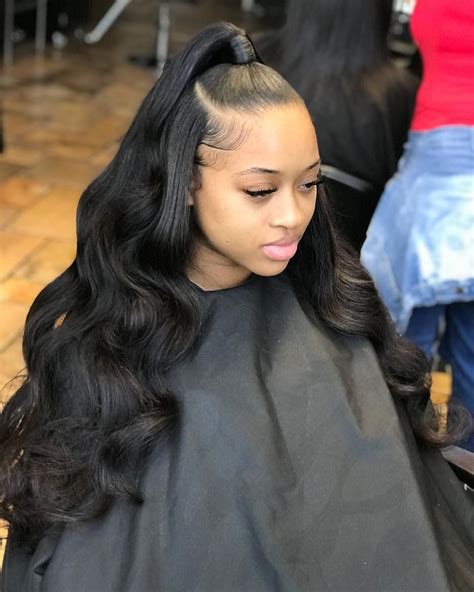Introduction
Hair weaving is a versatile and popular hair extension technique that allows individuals to enhance the length, volume, or texture of their natural hair. With an array of hair types and weave methods available, navigating the world of hair weaves can be overwhelming. This comprehensive guide will empower you with the knowledge and tips to achieve your desired weave look, whether you’re a seasoned pro or a weave newbie.

Types of Hair for Weaves
1. Human Hair Weaves
- Premium Quality: Natural-looking and durable, with the ability to blend seamlessly with your own hair.
- Costly: Can be expensive, especially for longer lengths and higher-quality grades.
2. Synthetic Hair Weaves
- Affordable: Budget-friendly and widely available in various colors and textures.
- Less Natural: May not blend as well as human hair and can become frizzy or tangled over time.
- Shorter Lifespan: Typically last for a few months before needing to be replaced.
3. Blends of Human and Synthetic Hair
- Hybrid Weaves: Combine the best of both worlds, offering a balance of natural appearance and affordability.
- Versatile: Can be customized to match your hair texture and desired look.
Weave Methods
1. Sew-In Weaves
- Secure and Long-Lasting: Weaves are sewn directly into your natural hair using a needle and thread.
- Versatile: Suitable for various hair textures and lengths.
- Can Damage Hair: Improper installation or tension can cause hair breakage.
2. Glue-In Weaves
- Quick and Easy to Apply: Bonds are attached to the hair using glue, creating a seamless blend.
- Less Versatile: Only suitable for specific hair textures, and removal can be difficult.
- Potential for Scalp Irritation: Glue can irritate sensitive skin.
3. Clip-In Weaves
- Removable: Attach to your natural hair using clips, allowing for easy on-and-off use.
- Convenient: Perfect for temporary hair extensions or special occasions.
- Limited Lifespan: Clips can loosen or break over time.
Considerations for Weave Installation
- Hair Type and Texture: Match the weave hair to your own hair type and texture for a natural blend.
- Head Shape and Hair Density: Avoid choosing weaves that are too heavy or voluminous for your head shape and hair density.
- Lifestyle and Activity Level: Consider your daily routine and activities when selecting a weave that suits your lifestyle.
- Budget and Maintenance: Weaves can vary in price and require regular maintenance. Factor these costs into your decision.
Tips and Tricks for a Flawless Weave
- Consult a Professional: Seek the advice of an experienced hairstylist to ensure a seamless installation and minimize damage to your natural hair.
- Use Quality Hair Extensions: Invest in high-quality hair extensions that are durable, easy to style, and match your own hair color and texture.
- Proper Hair Care: Follow a regular hair care routine to maintain the health and longevity of your weave, including washing, conditioning, and detangling.
- Avoid Heat Damage: Limit the use of heat styling tools, as excessive heat can damage the hair extensions and your natural hair.
Common Mistakes to Avoid
- Over-Weaving: Don’t overload your head with too much hair, as it can cause discomfort, hair loss, and scalp damage.
- Improper Installation: Ensure that your weave is installed properly to avoid hair breakage or tension on your natural hair.
- Neglecting Hair Care: Proper hair care is crucial. Neglecting to wash, condition, and detangle your weave can lead to dryness, tangles, and scalp irritation.
- Using Harsh Chemicals: Avoid using harsh chemicals or products on your weave, as these can strip away the natural oils and damage the hair.
FAQs
1. How long does a weave last?
- A well-maintained weave can last anywhere from 6 to 12 weeks, depending on the installation method, hair type, and care routine.
2. Can I swim with a weave?
- It’s not recommended to swim with a weave, as chlorine and saltwater can damage the hair extensions and your natural hair.
3. How much does a weave cost?
- The cost of a weave varies depending on the hair type, length, installation method, and stylist’s fees. It can range from a few hundred dollars to over a thousand dollars.
4. Can weaves damage my natural hair?
- Weaves can potentially damage natural hair if installed improperly or worn for too long. It’s important to consult a professional hairstylist and follow proper hair care practices.
5. How do I remove a weave?
- Weaves should be removed by a professional hairstylist to avoid damaging your natural hair. They will use a special removal solution to dissolve the glue or thread holding the weave in place.
6. Can I bleach a weave?
- It’s possible to bleach synthetic hair weaves, but it’s not recommended to bleach human hair weaves, as it can damage the hair and alter its texture.
7. How often should I get a weave retouched?
- Weaves typically need to be retouched every 4 to 6 weeks to tighten the installation and prevent slippage.
8. Can I sleep with a weave?
- It’s important to protect your weave while sleeping. Use a satin pillowcase or wrap your hair in a scarf to minimize friction and prevent tangles.
Conclusion
Hair weaving is a versatile hair enhancement technique that can transform your locks and boost your confidence. By understanding the different hair types, weave methods, and tips and tricks outlined in this guide, you can make informed decisions and achieve a flawless weave that complements your style and enhances your overall look. Remember to consult a professional hairstylist for a tailored recommendation and proper installation to ensure the longevity and health of your natural hair.
